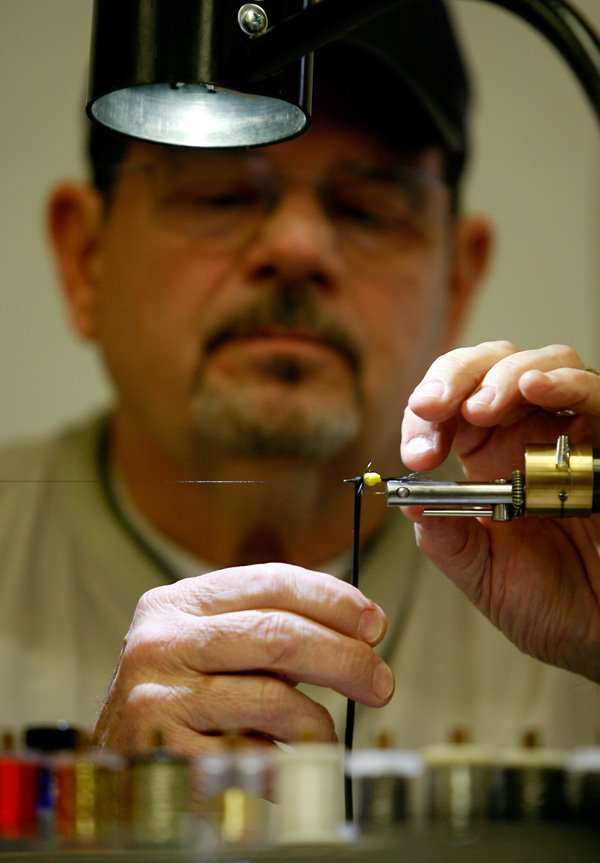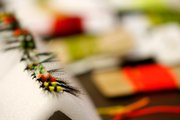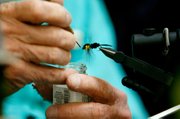If you find yourself in the presence of a woolly bugger, a green fuzzy wuzzy or a Montana nymph, you’ve probably wandered in to a fl y tying class.
Two small groups of men gathered around Monday as Bella Vista Fly Tyers constructed a variety of the exotically named flies. One was a class for beginners, and the other was an advanced class. Both were for Fly Tyers members, but the public is welcome to come and watch at noon each Monday through the end of March at Riordan Hall in Bella Vista.
Fly tying is one of the oldest arts, said Jack Price, president of the Bella Vista Fly Tyers.
Materials are wrapped around hooks, which are mostly barbless ones because fisherman don’t want to hurt fi sh that they decide to catch and release when fly fishing, he said. Their creations are used to imitate flies that fish feed on, so they “fool fish.”
Materials to make the flies include chicken feathers, turkey feathers and deer hair. Price said any kind of fur can be used, adding that many people recycle material from old coats. Some materials used are buoyant to make dry flies, and others are used to make flies that will go below the surface, he said.
Gary Rowland, a seven-year member of the Fly Tyers, said he has all kinds of materials he’s accumulated over the years. He said he has stopped his car before to cut a tail off a fox squirrel that was roadkill so he could use it for fl y tying material. He has also cut pieces off his wife’s old leather purses.
Price noted that hooks are the most important aspect of flies, though.
Rowland said the dry flies have a lighter hook, and the heavier metal hooks help the flies sink.
When Rowland goes fly fishing, he said he takes about half a dozen flies. He has two or three varieties tied in different color combinations because sometimes fish prefer one color over another.
He tries to mimic the natural bait the fish like.
He said brim like bright colors such as yellow, orange or fluorescent green, for example.
Price said this process is called “match the hatch.” To do this, a fisherman can go to a stream and see what the fish are feeding on.
He can catch the flying insect and see what ties are in his tackle box that can mimic it.
Price said if someone catches a fish on a fl y he has tied, “there’s just nothing like it.”
Price said there are about 3,500 fl y tying patterns. In this week’s fly tying class, beginning class members were making a Montana nymph, wrapped with wire first to help it sink down and then wrapped with other materials, Vice President Wilson Scott Jr. noted.
The materials included hackle and chenille, Price said, with the intention of attracting trout and bluegill.
Scott said this fly might take about 10 minutes to create, and Price said it would likely take him a only couple of minutes.
Don Chapman, who has taught the beginning class for 23 years, said he has about 3,500 flies in his collection.
“I make more than I need. It’s just a compulsion,” he said.
Also constructed by the Fly Tyers was a woolly bugger.
Rowland said the materials for that fl y include wire to weigh it down along with marabou, hackle and chenille. It can be used to catch trout, bass, crappie and bluegill, which is also known as brim.
P rice added that the woolly bugger fl y can imitate many insects and looks a little bit like a caterpillar on the front and then has a tail made from marabou.
Meanwhile, the advanced class was making a fly called a green fuzzy wuzzy. Rowland teaches the advanced class with John Blair and said some of the advanced flies are complex and can take an hour to create.
Rowland does fly tying as a hobby. He said some people do it as an art form and don’t even fl y fish and, he added, there are some women members who have smaller, more nimble fingers and tie gorgeous flies.
People who are retired can have a lot of time on their hands, and he said he spent many days in the winter fly tying in his workshop set up for this hobby. If his wife can’t find him, she knows the first place to look.
“I tell her my doghouse is well equipped,” he joked.
Life, Pages 6 on 03/06/2013



